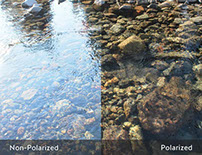
All About the Lens Type, Material, and Coating
The style of your frames contributes to how the world sees you,
however, Lenses determine how you see the world.
A perfect pair of glasses is the right combination of frame and lens.
At Salem's Eye Professionals, we apply your unique prescription to the best lens type, made with the best lens material and finished with the best lens coating to meet your lifestyle within your budget. You'll See the Difference!
Lens Types
LENS TYPE refers to how the lenses are manufactured to meet the needs of your prescription best.
Single-vision prescription lenses are for people who need to correct one field of vision, either distance or near. As people age and vision changes occur, it is common that single vision glasses are no longer adequate, and lenses such as bi-focal or progressive correction are required.
Progressive lenses have a distance correction in the top half and a reading correction in the bottom half of the same lens, with an intermediate region in between. Over the years, progressives have replaced bifocals and trifocals as the lens of choice for multifocal prescriptions, as they offer a seamless transition from distance to near vision.
Custom progressive lenses provide the wearer with enhanced benefits, such as:
- A wider field of vision
- Easy to get used to (higher adaptation rate)
- Easier focus
- Minimal distortion in side-to-side viewing
Also, advanced measurement technology is allowing for additional features, such as:
- A customized, precise prescription
- Better night and low-light vision
- Improved color vision
- Enhanced visual contrast
- Clearer, crisper vision overall
Customized lenses are made using free-form technology, also known as digital surfacing. This technology is quickly becoming the preferred way to make lenses, using state-of-the-art lens processing equipment and advanced digital lens design to deliver the most precisely crafted lenses possible. This allows the creation of exclusive, customized lenses that address patients' specific visual requirements.
Lens Materials
Lenses can be made from various materials, and each has different benefits, including price, weight, thickness, clarity, strength, and scratch resistance.
CR 39® is the most common optical polymer in the ophthalmic field. It refers to the type of plastic used to make prescription lenses. The lens comes from pouring the liquid polymer into a mold of optically treated glass. It provides very little distortion, is more lightweight and thinner than glass making it comfortable to wear, and it is more impact resistant though it may still break and shatter upon impact. As such, it is not recommended for active sports.
Advantages:
Good optical quality.
Lightweight - About half the weight of glass lenses.
More shatter resistant than glass lenses.
Plastic lenses accept tints easily with uniform grade colors.
Disadvantages:
About 20 to 35 percent is thicker than polycarbonate or high index plastic lenses.
Require scratch-resistant coating for added durability.
Require a special coating to provide 100% UV protection.
Polycarbonate is one of the strongest and safest materials on the market. They have exceptional strength and resilience. They will survive the impact of a steel ball traveling at 160 km/hr without shattering, which meets EN/EU grade for Low Energy Impact Resistance (small particle).
Our entry-level glazing packages offered for our rimless and semi-rimless glasses are polycarbonate lenses. Due to the nature of these frames, where the lenses have to be drilled or clipped into the frame, polycarbonate will greatly reduce the possibility of damage.
Advantages:
Excellent impact resistance - 10 times more impact resistant than other lenses.
Thin - About 20 to 25 percent thinner than plastic or glass lenses.
Lightweight - About 20 percent lighter than plastic lenses.
Blocks 100 percent UV rays without needing a special coating.
Disadvantages:
Requires scratch-resistant coating for durability.
Peripheral vision may be slightly less clear in strong prescription powers.
More lens reflections than glass or plastic lenses (AR coating recommended).
Lenses made with Trivex material are a great choice for anyone who leads an active life and expects clear, crisp vision correction, lightweight comfort, and protection from their eyewear.
Like polycarbonate lenses, lenses made of Trivex are thin, lightweight, and much more impact-resistant than regular plastic or glass lenses.
Trivex lenses are composed of a urethane-based monomer made from a cast molding process, similar to how regular plastic lenses are made. This gives Trivex lenses the advantage of crisper optics over injection-molded polycarbonate lenses.
Mid and high-index lenses are for people with a high prescription. They allow spectacle lenses to be thinner, lighter, and flatter than previously possible. They are compressed lenses that offer better optical viewing through them. For higher prescriptions, they not only reduce the weight by up to 50% but also reduce the thickness by up to 60% making them more attractive cosmetically. In addition to making the glasses look cosmetically better, they will feel lighter on your nose, and the flatter shape of the lens will make things look less distorted towards the edges of your lenses.
Advantages:
Lightweight - Between plastic and polycarbonate lenses in weight.
Thin - About 15 to 30 percent thinner than plastic lenses.
Better peripheral optics than polycarbonate lenses (for prescription sunglasses).
Disadvantages:
Requires scratch-resistant coating for durability.
More lens reflections than glass or plastic lenses (AR coating recommended).
1.74 high index lenses are the thinnest and lightest plastic lenses.
If you’re trying to decide between 1.67 vs. 1.74 high index lenses, here are the differences:
1.74 high index lenses are thinner and lighter than 1.67 high index lenses.
1.67 high index lenses are much less costly compared to 1.74.
Though both reduce the eye distortion caused by strong prescriptions (making your eyes look bigger or smaller than they are), 1.74 high index lenses accomplish this better than 1.67 high index lenses do.
1.67 high index lenses are available in more colors: both come in clear, gray-tinted, and brown-tinted, but only 1.67 comes in Transitions brown or gray.
1.74 high index lenses are better for those looking for the thinnest lens possible; generally, people with extremely high prescriptions choose this option.
1.67 high index lenses are better for those looking to save money or those who do not have extremely high prescriptions. They are also the only choice if you’re looking to get Transitions.
No matter which you choose, your high index lenses are going to be thinner, lighter, more attractive, and more scratch-resistant than standard plastic lenses.
Originally, all lenses were made of glass, which, while it made them very resistant to scratching, also made them very heavy and prone to breakage. These lenses are now becoming obsolete, except for toughened lenses for industrial safety glasses.
Advantages:
Exceptional scratch resistance (don't need scratch-resistant coating).
Excellent optical clarity.
Anti-reflective (AR) coating adheres to glass very well.
Disadvantages:
At least twice the weight of plastic or polycarbonate lenses.
About 25 to 40 percent is thicker than polycarbonate and high index plastic lenses.
Can shatter or chip easier than lenses made of other materials.
Require a special coating to provide 100% UV protection.
Mineral glass lenses offer unmatched optical clarity with the lowest distortion rate, making this a preferred choice for sunglasses. It is amazingly tough. Advantages include superior clarity, low care requirements, and high scratch resistance; however, the somewhat higher weight is a slight disadvantage. Mineral Glass lenses dramatically increase lens hardness and up to 6x scratch resistance and reduce both reflections and bounce-back reflections. Provides100% UVA and UVB protection, blocking harmful rays from the sun, fluorescent lights, and computer screens.
• Best optical clarity
• Virtually no distortion
• Lenses thinner than plastics
• Can be coated and tinted
• Prescription compatible
Lens Coatings
Special coatings can greatly improve the quality of your vision and the durability of your lenses.
Learn about the many options available.
Photochromic lenses are eyeglass lenses that are clear (or nearly clear) indoors and automatically darken when exposed to sunlight. It's like having prescription sunglasses and regular glasses in one.
Other terms sometimes used for photochromic lenses include "light-adaptive lenses" and "variable tint lenses."
Anti-reflective lenses, also known as AR, are best for reflecting light, especially while driving and for an extended time at a computer. Due to the layering effect of AR, some lenses may have a green or purple tint.
Our bodies have an internal “clock” that regulates our circadian rhythm, the 24-hour biological cycle that influences many internal functions. It determines when our bodies are primed to stay awake and productive and when we feel tired and want to sleep.
Light of a blue wavelength (blue light) stimulates sensors in the eye to send signals to the brain’s internal clock. Getting blue light (especially from the sun) in the daytime is very important, and it helps us stay alert while improving performance and mood.
However, if we are exposed to it in the evening, blue light can keep us awake.
The problem is that modern light bulbs and electronic devices (especially computer monitors) produce large amounts of blue light and “trick” our brains into thinking it is daytime.
This means that our bodies don’t get the proper signal that it’s time to sleep, reducing both the quantity and quality of our sleep.
Using Blue-Blocking Glasses at Night is a Simple Way to Solve This Problem. These glasses effectively block all blue light, so your brain doesn’t get the signal that it is supposed to stay awake.
Polarized lenses have a special coating that provides the user with many benefits. The lenses are treated with a special chemical film or coating that reduces glare, making objects much clearer. Polarized lenses can help reduce the harmful effects of glare on people’s eyes.

A mirror coating is applied to the lens to prevent light from reflecting into the eye. The coating makes the outside of the lens look like a mirror. The wearer does not see the mirror coating from inside the lens, just the color tint of the coating.
